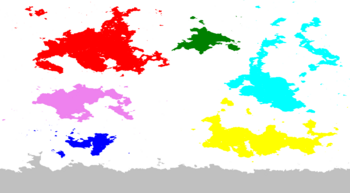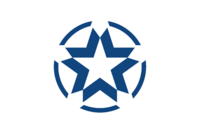United Nations (Elezia)
This article is incomplete because it is pending further input from participants, or it is a work-in-progress by one author. Please comment on this article's talk page to share your input, comments and questions. Note: To contribute to this article, you may need to seek help from the author(s) of this page. |
United Nations
| |||||||
|---|---|---|---|---|---|---|---|
 Map of Elezia with distinguished continents | |||||||
| Headquarters | UN Complex, Jefferson, United Federation of Triania (International territory) | ||||||
| Protocolar language | English | ||||||
| Type | Intergovernmental organization | ||||||
| Membership | 221 members | ||||||
| Leaders | |||||||
• Chairman | Jane Doe | ||||||
• Deputy Chairman | Nadal Rashik | ||||||
• President of the General Assembly | Maria Hasaan | ||||||
• President of the Security Council | Juan Hernandéz | ||||||
| Establishment | |||||||
• UN Charter signed | 20 October 1958 | ||||||
• Charter entered into force | 1 January 1959 | ||||||
| |||||||
The United Nations, also referred to by its initials as the UN, is a geopolitical orginization in Elezia, aiming for world peace and better understanding among nations.
History
TBA
Organizations
- General Assembly - The General Assembly is responsible for passing resolutions of the World Assembly
- Security Council - The Security Council is responsible for fast response by the UN and can be overturned by later vote
- Agency for Sciences, Education and Culture - Organization for sharing of scientific, educational and cultural findings and promotion of cooperation among nations
- Agency for Human Rights and Dignity - Organization serving to oversee the politics and try to prevent human right violations
- Agency for Global Economics and Trade - Organization for better economic cooperation among the nations
The organizations retain full autonomy with the same structure as before they joined UN and membership in them is not mandated to UN members and vise versa. Only exception is, that the branches have right to mandate their respective fields in a dispute between countries, that are not members of their branch, but are a member of UN if at least one of the countries involved in the dispute asks for the mediation.
General Assembly
All 221 members have one vote each and decide on issues relevant to the AWA. Due to multiple election systems or decisionmaking in specific regions, countries are assigned to "Continental groups" based on what continent they are located on.
Continental groups
TBA
Exceptions and irregularities in the groups
Because of multiple irregularities and problems with countries overlapping the continents, some countries form exceptions in the groups. Those include:
Voting in the General Assembly
Currently, once the vote is proposed, nations have 72 hours to cast their vote based on the options.
Binary voting
In binary voting, countries vote either AYE (Approval), NAY (Disapproval) or IDC (Neutrality) on the issue discussed (or, if the vote is a continuation of a previous votem picking from 2 variants). Vote can be ended prematurely if Absolute majority votes in favor or against the proposal. If absolute majority is not reached in 72 hours, neutral votes are excluded and relative majority from the cast votes is picked.
Voting on more options
Voting on more than 2 options is done by approval voting with the option with the most votes is picked after 72 hours (Absolute majority on one vote can of course skip this process prematurely, but voters are reminded to cast their votes so it can be seen if more options reach absolute majority)
Security Council
Security Council is a fast-response body of the UN tasked in reacting swiftly to threads cast on the UN. Any SC decision can be overturned with absolute majority of votes. Security council consists of 25 seats, 5 of which are permanently filled and the remaining 20 rotate countries regulairly.
Security council votes on condemnations, commending and recognition of grassroot governments. Its votes can be questioned and brought to the UN as a whole and can be overturned by a absolute majority of votes going against the decision made by the Security Council.
Permanent membership
Temporary membership
TBA
Associated organizations
TBA




